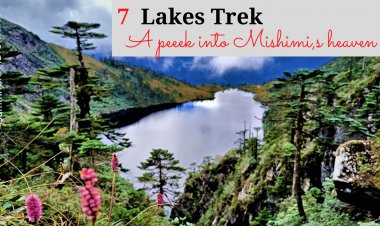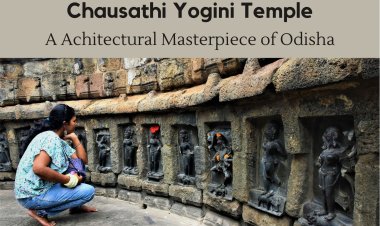Panchkedar : A Pilgrimage to Abodes of Shiva
Panch kedar known asthe abodes of lord shiva is said to bebody parts of shiva is said to be appeared in different regions of Himalayas and revered to as the site of holy shrines.The shrines dedicated to pandavas too, can only be reached by foot only.The circuit trek takes around 14days and is a life cahnging expereince too.
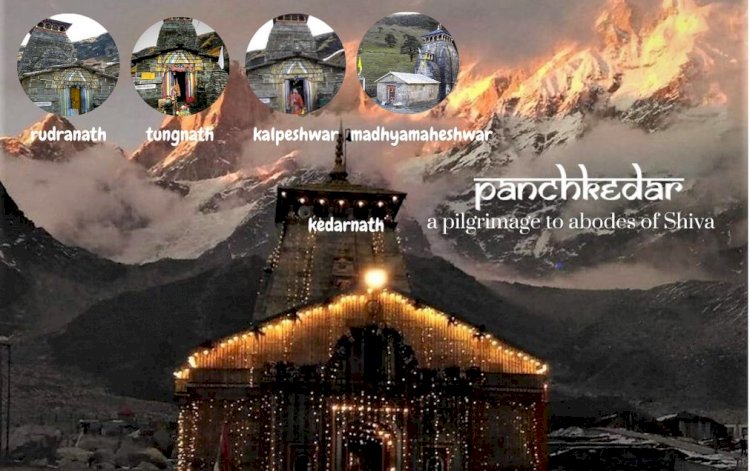
Uttarakhand is known as devbhoomi, or “land of the gods,” since it is home to several Hindu holy sites. Furthermore, source of some of India’s most holy rivers.
Many temples spread across the whole of the Uttarakhand in the abode of Himalayas.Likewise, there are five temples of Lord Shiva that have been established in the Garhwal region of Uttarakhand collectively known as Panch Kedar which are Kedarnath, Tungnath, Rudranath, Madhyamaheshwar, and Kalpeshwar. According to our legends , these temples date back to epic Mahabaharata and said to be formed by the Pandavas after the great war with their brothers. These temples represent body part of Lord Shiva existing in each temple.in different forms
Panch Kedar yatra is a sacred yatra for an individual, who is religiously inclined. Here we explore each one of them which forms Panch Kedar

Highlights of the Panch Kedar Trek -
- You have to travel and trek to all five Panch Kedar temples in a single journey.
- You need to fit to walk 5 - 6 hours a day carrying a backpack.
- Trekking inside deep forests and reach summits with spell bounding mountain views.
- The availability of dhabas on the trail and budget stay options allows you to pace your trek according to your fitness level and the amount of time you have.
Legend: According to mythological stories, there is an incident that explains about the creation of all these Kedar. The great warriors Pandavas when they defeated their brothers “Kauravas” and relatives in the war that took place in Kurukshetra. After this scenario, Pandavas went into the guilt of killing their brothers and their own blood but it is their Dharma to do so as they were all standing on a battlefield. For the atonement of their acts, they went to Varanasi in the search of Lord Shiva to get rid of their bad acts. But when they didn’t find Lord Shiva there, they came to Garhwal region in the foothills of the Himalayas.
The second of all Pandavas brothers named Bhima started searching for Lord Shiva then he saw a Bull roaming and grazing in that area which is now called “Guptkashi”. Bhima took hold of that bull by its tail. As soon as Bhima got hold of that bull or Lord Shiva, it disappeared into the Earth and later arose in five different places with different body parts. Lord Shiva appeared with his hump or back in Kedarnath, arms appearing in Tungnath, Face in Rudranath, the stomach, and navel in Madhyamaheshwar, and the hairs in Kalpeshwar. Thus, Pandavas got impressed by this and then formed temples in those places for worshipping Lord Shiva. This is how Panch Kedar originates and consists of a huge value.
Kedarnath
Altitude 3,583 m (11,755 ft)
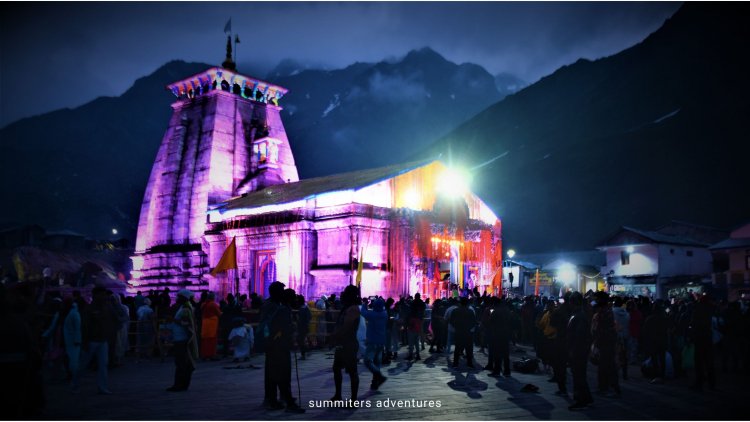
Kedarnath is regarded more important than any other kedar included in Panch Kedar. Kedarnath is located in the Rudraprayag district of Uttarakhand state which is primarily located in the Garhwal region. This temple has been closed for six months due to heavy snowfall in that region. During the course of time, the idol of Lord Shiva is shifted to Omkareshwar temple which is located in “Ukhimath”.
Kedarnath shrine is the first that has to be visited out of all the Kedar’s during Yatra because of the indulgence of this temple in Char Dham Yatra too, it becomes so pious and sacred also. After this act of making temples, Pandavas went to heaven by going through Badrinath, the point from which they went to heaven called “Swargarohini”.beyond Sathopanth Taal.
How to Reach?
One has to trek to reach this temple, be prepared to hike 18 km which starts from a point called “Gaurikund”. There is a point situated halfway through the trek called “RamBada”.
In recent years, a cloud burst followed by a flood took place in June 2013 which caused huge damage. All the surroundings, hotels, shops, and bridges got wrecked but the temple didn’t affect it a bit. When the water of the River Mandakini comes with an immense force towards the temple, a massive stone comes in the back of the temple to protect it, this stone divides the water into two streams which go away from the sides of the temple. Known as Bheem Shila
According to legends, it is said that Lord Shiva exists there and protects the temple from every disaster. There is another belief, that Baba Bhairav Nath is protecting the temple as his own temple is situated nearby. He is also called “Kshetrapal” which is an avatar of Lord Shiva who stands for the act of destruction and devastation.
Tungnath
Altitude 3,690 m (12,106 ft),
Tungnath is considered as the highest of all Shiva temples It is the second temple in the Panch Kedar. This temple has the legs of Lord Shiva when he appeared in the form of a bull. This temple is similar to Kedarnath in its structure, located in between the mountains. It is said on the basis of mythology that Lord Shiva and his wife Goddess Parvati live here in the Himalayas. Lord Shiva himself lives on the peak of the mountain named “Mount Kailash” and Goddess Parvati also lives here as She is also called “Shailaputri”, the daughter of the Mountains.
Tungnath temple also called Tungnath Mahadev which is located in the Rudraprayag district in Uttarakhand. This is the temple that forms the Mandakini and Alaknanda river valleys. Tungnath literal meaning is “Lord of the Peaks”, which can be justified as it is located in the highest place among all the Panch Kedar.
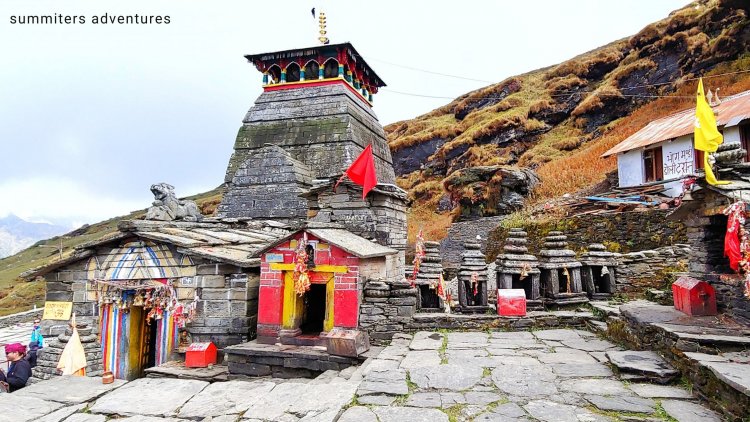
"Worlds Highest Shiva Temple" Tungnath
Trek: The trek to Tungnath starts from a point called “Chopta”. This Panch Kedar Trek of Tungnath from Chopta is like 5 km which is covered in snow in winter times and so difficult to trek. This temple also closed in winter times and has been shifted to temple at Makkumath because of the climatic conditions which get harsh in winter. Chopta is an untouched place that can offer serene views of Himalayan peaks such as, Chaukamba, Bandarpoonch. and other peaks.
At a 2 km distance from the temple Tungnath, there is a highest point named Chandra Shila which literally means “Moountain of Moon or the Place of the Moon God”. This trek to Chandra Shila is very difficult but at the same time, a mesmerizing one.
This place has value because of a belief that Lord Rama along with his younger brother Lakshmana came here after killing Ravana to meditate to get the blessings of Lord Shiva so that they can get rid of the guilt of killing Ravana. During this time of meditation and penance, Lord Rama built the temple “Ramanathaswamy” in Rameshwaram in Tamil Nadu which is considered one of the 12 Jyotirlingas.
Rudranath
Altitude 3,600 metres (11,800 ft)
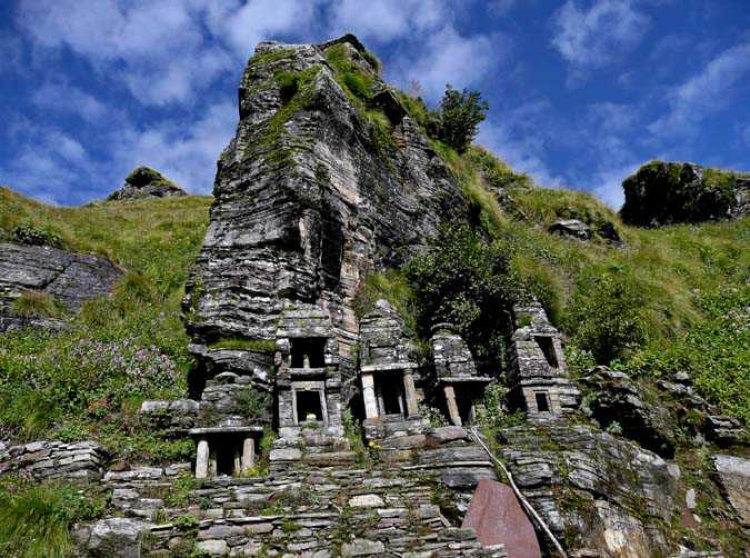
Rudranath is the third temple in the Panch Kedar Yatra after Kedarnath and Tungnath. Here, Lord Shiva is worshipped with his face appearing at this temple. This temple consists of the most difficult trek among all other Panch Kedar. According to the legends – this temple consists of a rectangular space outside the temple which is believed to be the place where Lord Shiva appeared Himself with His face in the form of a huge rock. The eyes were so innocent and a smile was there on the face of Mahadev. Here Lord Shiva has been worshipped as “Neelkanth Mahadev”.
Rudranath literally means “He who is angry”. Lord Shiva is very calm in nature but when His third eye gets opened because of anger then it is said that the destruction of the world is going to happen. Rudranath is the fourth shrine in the series of holy Panch Kedar. The temple was originally constructed way back in the 8th Century AD.
There is a river flowing near the temple named Rudraganga which is believed as the “River of Salvation”. The souls of many dead people are believed to cross the world through this river. Due to this belief, most people came here to offer Pind with the name of their ancestors so that their souls will remain free and not in any shackles of anything.
The temple is surrounded by a number of pools ( Natural water springs )– Surya Kund, Chandra Kund, Tara Kund and Manas Kund – while the great peaks of Nanda Devi, Trishul and Nanda Ghunti rear overhead. It is the toughest trek to reach as compared to other Panch Kedar dham of Lord Shiva. Devotees generally take bath in the Narad Kund prior to visiting the temple.
The deity is a Swyam Bhuva (Self Appeared) Shivalinga shaped like a human face formed by the projection of a huge rock. This face has a serene smile and a gaze of pure benevolence in the all-seeing eyes. Measuring about 3 feet from the chin to the top of the jatas, a white cloth remains bound tightly on the crown of Lord Shiva.
Hot to reach the shrine?
By Trek: This Panch Kedar Trek for Rudranath starts from a village i.e., Sagar village which lies on the route of Mandal village and Gopeshwar near to Chamoli. This trek is 20 km long and very hard because of the steep climbing and slippery road. The way to this temple goes on with the dense forests of Alpine and many more. The trek consists of many water tanks or kund which are Surya Kund, Tara Kund, Chandra Kund, and Mana Kund. You can witness the view of Nanda Devi, Hathi Parbat, and the peak of Trishul from a high place called the Panar Enroute to this place.
This place is called to be protected by the Vandevi or Vandevtas (The God and Goddess of forests). There is a celebration of an annual fair that takes place on the full moon day in the Month of Shravan, mostly occurring on the day of Raksha Bandhan.
Madhyamaheshwar
Altitude 3,497 m (11,473.1 ft)
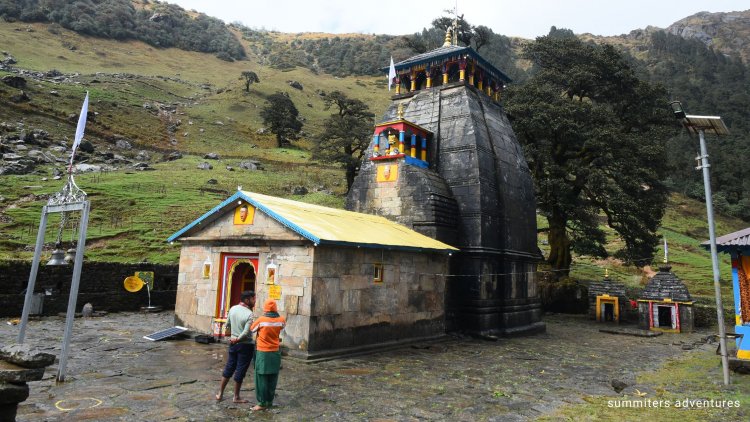 Madhyamaheshwar is the fourth temple among the Panch Kedar and the fourth one that exists in Panch Kedar Yatra. Lord Shiva was worshipped here with the appearance of his stomach and belly button (Navel) or Middle part of the body. This temple is located in the Mansoona village in the Garhwal region of Uttarakhand. This temple is situated in the area known as Chaukhamba Peaks which means surrounded by four peaks or four pillars.
Madhyamaheshwar is the fourth temple among the Panch Kedar and the fourth one that exists in Panch Kedar Yatra. Lord Shiva was worshipped here with the appearance of his stomach and belly button (Navel) or Middle part of the body. This temple is located in the Mansoona village in the Garhwal region of Uttarakhand. This temple is situated in the area known as Chaukhamba Peaks which means surrounded by four peaks or four pillars.
There is an old temple, called Vridh-madmaheshwar, which has a small blackened shrine of Lord Shiva. But in Madhyamaheshwar, there is one Idol of Lord Shiva in the form of a Navel and another one of Goddess Parvati. There is one more idol which is half of Lord Shiva and Mata Parvati called Aradhanarishwara.
How to Reach the Shrine?
One has to reach Ransi Vilage and start trek from a point called Uniana, from there the distance is about 21 km which is a moderate trek, not hard like Rudranath. There are two main points that come in between the Trek which are Gaundhar and Kalimath. Kalimath is the place that offers an environment that is suitable for spiritual peace that’s why it is called as Sidh Peeth. Here, a temple of Goddess Durga or Mahakali and Lord Shiva in the Avatar of Baba Bhairava is situated.
On the other hand, Gaundhar offers a picturesque view that can take away all your tiredness in a minute as it is the point of confluence of Madhyamaheshwar Ganga and Markandeya Ganga. The Water from this place has been so valuable and considered as nectar, even some drops of this water is enough for the Purification of our soul. This place is so crowded at the time of Navratri every year.
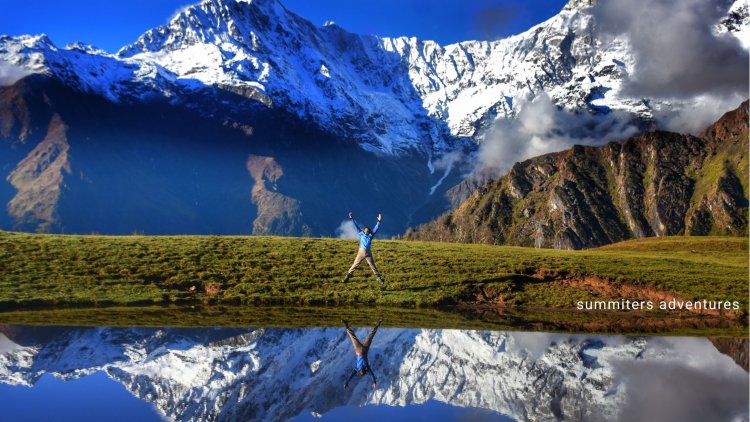
Kalpeshwar
Altitude 2,200 m (7,217.8 ft)
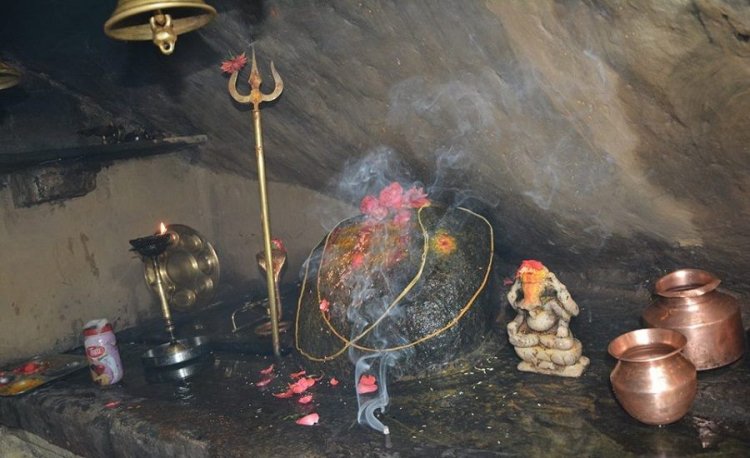
Kalpeshwar is the last temple to have existed in the Panch Kedar Yatra.In this temple, Lord shiva’s hair or Jata (Tress) has existed and is worshipped by everyone. This temple is located in the Urgam Valley which is a sacred place to visit, in the Garhwal region
How to Reach Shrine?
Reach the village of urgam from Helang. After crossing the Kalpa Ganga, an uphill hike brings to the cave of Kalpeshwar Mahadev located precariously in the hills. You can even visit Dyan Badri and Budha Kedar which is proximity to the temple.
The Panch Kedar yatra is only for those who can undertake the yatra on foot. During the pilgrimage covers the five shrines located in remote corners and dedicated to Lord Shiva but also allows you to get acquainted with the remote villages that exhibit an ancient charm.
The entire trail from Gaurikund to Kedarnath en route to Rudranath, Mandal, Chopta, Gaundhar, Tungnath, and Madhyamaheshwar offers immense opportunity to get fascinated by the nature of the place which is blessed with the snow-capped peaks rising above the dense forest and lush green meadows, with turbulent rivers rolling down the valleys.
Tour Itinerary
Travel Tips for Panch Kedar Yatra
- When Travelling to the Panch Kedar, make sure you are physically fit as this journey requires you to be in the optimum state of health with any health issues
- Pack and carry the essential things you need in Panch Kedar such as power banks, first aid medicines, creams, energy bars, and warm clothes depending on the travel month you choose. Avoid July and August as it's the rainy season.
- The Panch Kedar is open for only 6 months except for Rudranath and Kalpeshwar which is accessible throughout the year.
- Check the opening and closing dates of Kedarnath, Tungnath, and Madhmaheshwar before you plan your journey
- The Panch Kedar is a long journey to be covered therefore plan your journey early in the mornings to reach the destination before dark.
With this, we wish the divine may shower you with all the divinity and motivation to undertake the spiritual in the Himalayas. Before traveling to the Panch Kedar make sure you thoroughly go through this Useful Guide to Panch Kedar.Yatra
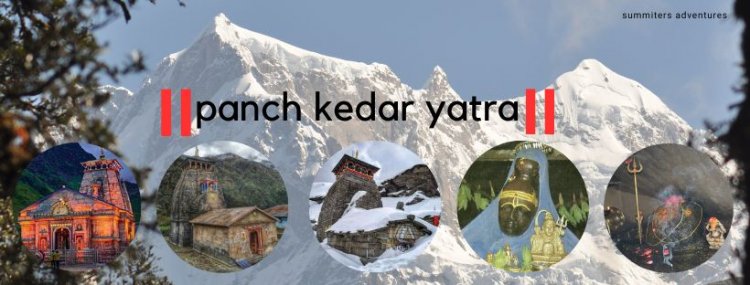
if you need any assistance to arrange a tour for you. Speak to us at +91 9740360365 or mail us at summitersadventures@gmail.com










